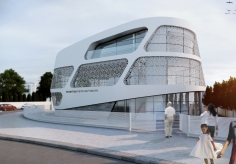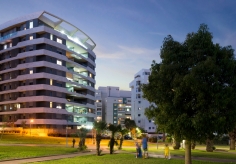Mixed-use planning is an architectural planning approach that seeks to maintain a wide range of activities and functions within a given area. Attempts are currently being made in Israel to create urban plans based on this approach, in which people could live, study, work and be entertained within one residential block, without wasting precious commuting time in their cars. The mixed-use methodology encourages social interaction between different groups of people. In fact, it is a return to a city for and by the people, one that strengthens community values that we have lost along the way.
Our cities are facing a serious challenge: on the one hand, an accelerating population intensification and vertical expansion are almost inevitable; on the other hand, we still retain the desire to integrate nature, our own unique customs, and human proportions wherever we live. Because of the shortage of land in our cities, we are obliged to build in higher densities. Consequently, modern high-rise residential neighborhoods are springing up, as often as not, before the proper public infrastructure has been laid down. These are the schools, day-care, clinics, shops and playgrounds – which also require land allotment.
The past years have seen a demand in Israel for a different kind of urban fabric that does not require long-distance transportation to education, health, shopping, leisure and working zones, one that offers an urban experience and does not alienate the individual. Just as Man seeks a balance in life between career and family, matter and spirit, office hours and pastime, so too should our cities strive to be.
Mixed-use is a traditional urban scheme related to many medieval cities, where a plethora of activities were practiced in the same immediate surroundings. Today, attempts are being made in Israel to create schemes of a similar nature, albeit on a larger scale, in which people could could live, study, work and be entertained within one residential area, without wasting precious commuting time in their cars.
 We have attempted to offer one such example in Ashdod’s Herzl District, a project planned for the Yashfe Urban Renewal Company. The district’s overall scheme provides accessibility, security and a sense of rural community in urban densities. Each particle within the project is designed as a block with public functions at its base: parking, commerce and school, binding together each residing group of families. The vertically-oriented school saves considerable space, with some of its playgrounds located on the upper floors. Above the school are more playgrounds and lawns, and above these – the residential towers. Correct proportions and a meticulous design are crucial in turning this schematic vision of mixed-use into a truly authentic location.
We have attempted to offer one such example in Ashdod’s Herzl District, a project planned for the Yashfe Urban Renewal Company. The district’s overall scheme provides accessibility, security and a sense of rural community in urban densities. Each particle within the project is designed as a block with public functions at its base: parking, commerce and school, binding together each residing group of families. The vertically-oriented school saves considerable space, with some of its playgrounds located on the upper floors. Above the school are more playgrounds and lawns, and above these – the residential towers. Correct proportions and a meticulous design are crucial in turning this schematic vision of mixed-use into a truly authentic location.
 The district effectually offers a rural lifestyle within urban building standards. In the morning the children are sent to school, in all types of weather, by means of elevators. At noontime they will proceed to their extra-curricular activities, visit their classmates or play on the lawn, without once coming near the road. In the evening, after parking the car at home – the family can enjoy a stroll, ice cream and some shopping in the district’s commercial floor. Parent-teacher conferences will be attended by all the neighbors, involving people who are really acquainted with one another. In fact, the tenants will hardly be required to leave the district, while benefiting from an impressive view and a central location.
The district effectually offers a rural lifestyle within urban building standards. In the morning the children are sent to school, in all types of weather, by means of elevators. At noontime they will proceed to their extra-curricular activities, visit their classmates or play on the lawn, without once coming near the road. In the evening, after parking the car at home – the family can enjoy a stroll, ice cream and some shopping in the district’s commercial floor. Parent-teacher conferences will be attended by all the neighbors, involving people who are really acquainted with one another. In fact, the tenants will hardly be required to leave the district, while benefiting from an impressive view and a central location.
 This residential district is not just another stack of apartments, but part of a living, breathing, around-the-clock organism. The towers are connected by the public functions and by the school in particular. The tenants are not mere individuals living in proximity to one another, but part of a true community. This mixed-use methodology creates more social interaction between different groups of people. In fact, it is a return to a city for and by the people, one that strengthens the community values that we have lost along the way.
This residential district is not just another stack of apartments, but part of a living, breathing, around-the-clock organism. The towers are connected by the public functions and by the school in particular. The tenants are not mere individuals living in proximity to one another, but part of a true community. This mixed-use methodology creates more social interaction between different groups of people. In fact, it is a return to a city for and by the people, one that strengthens the community values that we have lost along the way.


